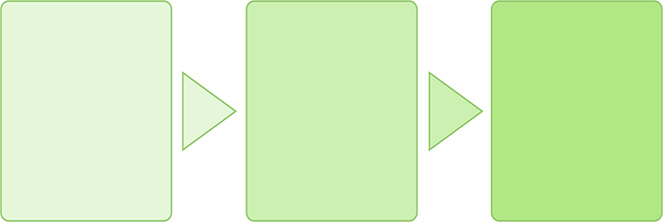Which study skills strategies can improve students’ academic performance?
Page 7: Time Management
Many students with learning difficulties—especially those with LD and ADHD—struggle to manage their time. They do not have a realistic sense of how long it might take to perform a task, such as completing their homework or a large project, often overestimating or underestimating the necessary time. They might also not recognize the extent to which competing activities (e.g., volleyball practice, talking on the phone) affect the time available to complete school-related tasks. This is why some students fail to complete homework or hand in poorly done work that was completed at the last minute. In many cases, the student has no idea why she or he had trouble finishing the task.
Listen as Hannah and Erin discuss how they manage their time. Note the differences in their approaches.
Transcript: Hannah
I would say I’m good at managing my time, because I play basketball and volleyball and so I have to be able to manage my time since I have extracurricular activities as well as all my homework and tests and other things I have to do. I love to write things down and be able to cross them out because I feel like I’ve accomplished something, I guess, when I cross them out. And so I do use a planner and write all my stuff down. It also helps me recognize that, hey, this isn’t the only thing that I have to do tonight. I need to study for my test and do my homework in this class tonight, and so I just don’t forget as much stuff. If I’m doing my homework, I usually have it out while I’m doing my homework so I can look at it and see, hey, I need to go ahead and do this because I haven’t done it yet or I need to study for this because I haven’t studied for it yet. And so I guess when I’m doing my homework, I usually have it out all the time just so I can see it. It kind of keeps me aware of the things I have and haven’t done.
Transcript: Erin
Managing time has always been an interesting topic for my life because I really don’t manage it. I put everything off, and I just mess around until it’s at the very last minute, and I have to get it done. And then I have a hard time realizing how long projects are going to take. I’ve often got into trouble at school because I would think, “Oh, well, this project will take just a couple of minutes tonight,” and really it’s a three-day project that I should have started days ago but I put it off until the very end, and then it’s not as good as it could have been if I had properly done the work. Honestly, how I approach big tasks is I wait until the last day and then do it all at once. I’ve had a couple teachers that, when they give big projects, they would break it down into smaller tasks, and it was very helpful for me because I can’t do that myself. If you give me a small task, like, say, write the first paragraph of this paper by this day, and then write the second paragraph and work in the first topic by this day, I can do that. I can do the smaller tasks, but I can’t do it for myself. And so it’s been a struggle to learn how to break it down appropriately because I’m not able to do that naturally. I personally don’t like checklists. It’s just a big list of things you have to do, and since I can’t prioritize tasks very well I tend to avoid checklists as much as I can.
Some students, like Erin, often have difficulty completing tasks due to poor time management skills. Teachers can help students better manage their time by teaching them how to estimate and schedule their time as well as monitor their schedule. For more information, select the corresponding headings in the graphic below.

Estimate how much time it will take to complete a task.
Use time estimates to make a schedule or timeline.
Create a system (e.g., to-do list) to make sure the task is completed.
Estimate Time
To help students better manage their time, teachers can provide instruction on how to estimate how much time it will take to complete a task. This can be accomplished using the steps listed below.
- Ask the students to estimate how long they think it will take to complete a given task (e.g., reading a section of the text and answering six comprehension questions, solving ten math problems, going to the library and checking out a book).

Note: It is beneficial to break up tasks, especially large projects, into smaller, more manageable chunks. Students who struggle with organizational skills will likely view a large project, such as a book report or a term paper, as a single mountainous task. They might not understand that the large task can be broken down into a series of smaller steps, thus making it much more manageable and less intimidating. To help students with this process, teachers can either routinely break large tasks into a series of smaller steps and provide the list of steps to the students or they can teach students how to break down tasks themselves (i.e., perform a task analysis). (See the example below.)
- Ask the students to perform the task so that they can determine how long it actually took.
- Discuss the results with the students.
- Highlight disparities between the estimates and actual time.
- Discuss why some students’ estimates might differ. For example, some students might write faster or be better at math.
- Discuss the importance of accurately estimating time. For example, if you were to underestimate the time it takes to drive to the movie theatre, buy a ticket, and find seats, you might miss part of the movie. If you were to overestimate it, you might have to wait a long while for the movie to start.
- To give students an opportunity to practice this process, ask them to think about a large upcoming assignment. First ask them to create a task analysis and to estimate how long it will take them to complete each step. (See the example below.) Next, the teacher and the students should share and discuss their time estimates. The teacher should highlight estimates that were unrealistic and help students make more realistic ones. Again, the teacher should stress that estimates can differ from student to student, and that this kind of variation is perfectly normal.
Example of a task analysis with time estimates
Assignment: Write a ten-page paper on a significant
20th Century historical figure
| Step | Time Estimate | |
| 1. | Decide on a historical figure to write about |
1 day |
| 2. | Go to library to check out books | 1 day |
| 3. | Find information on the Internet | |
| 4. | Read the sources | 3 days |
| 5. | Take notes | |
| 6. | Organize notes | 1 day |
| 7. | Write first draft | 3 days |
| 8. | Edit first draft | 1 day |
| 9. | Write final draft | 2 days |
| Total est. time: | 12 days |
In the event that students become overwhelmed by the idea of completing a large assignment or at the amount of time a task will take, teachers can assure them that they can complete the task if they schedule time for each of the steps. (See the link Schedule Time.)
(Close this panel)
Schedule Time
Once students have learned how to estimate how much time it will take to complete a task, they should be taught how to schedule their time. The teacher can show the students how to use these estimates to make timelines. Two methods are described below. Though the first is easier for students to implement, the second might be more beneficial because it gives each student a better idea of when to start working on the project.

A simple method is to have students add up the time estimates for each task to get the total estimated time. This gives them an idea of how long the project will take and a rough idea of when to start.
Example of a task analysis with time estimates
Assignment: Write a ten-page paper on a significant
20th Century historical figure
| Step | Time Estimate | |
| 1. | Decide on a historical figure to write about |
1 day |
| 2. | Go to library to check out books | 1 day |
| 3. | Find information on the Internet | |
| 4. | Read the sources | 3 days |
| 5. | Take notes | |
| 6. | Organize notes | 1 day |
| 7. | Write first draft | 3 days |
| 8. | Edit first draft | 1 day |
| 9. | Write final draft | 2 days |
| Total est. time: | 12 days | |
 A better method is to have the students use a calendar and work backwards. Students start at the due date or slightly before and fill in the tasks, something that will give them a better idea of when to start working on the project. When teaching this method, teachers should discuss how building in a little extra time is beneficial in case something unexpected comes up. They should also model how to incorporate outside events (e.g., family trip, soccer practices, a part time job) so that students understand that they should incorporate these events when they plan. Below is an example of a calendar (or a timeline) completed by a student who has been assigned a research paper.
A better method is to have the students use a calendar and work backwards. Students start at the due date or slightly before and fill in the tasks, something that will give them a better idea of when to start working on the project. When teaching this method, teachers should discuss how building in a little extra time is beneficial in case something unexpected comes up. They should also model how to incorporate outside events (e.g., family trip, soccer practices, a part time job) so that students understand that they should incorporate these events when they plan. Below is an example of a calendar (or a timeline) completed by a student who has been assigned a research paper.
| Monday | Tuesday | Wednesday | Thursday | Friday | Saturday | Sunday |
|---|---|---|---|---|---|---|
| 1 | 2 | 3 | 4 | 5
Decide on topic
|
6
Family Trip
|
|
| 7
Library and Internet search
|
8
Drama Club Mtg, Basketball Practice |
9
Read and Take Notes
|
10
Basketball game (away)
|
11
Read and Take Notes
|
12
Read and Take Notes
|
13
Youth Group Activity
|
| 14
Organize Notes
|
15
Write First Draft
|
16
Write First Draft
|
17
Write First Draft
|
18
Edit First Draft
|
19
Band Trip
|
20
Band Trip
|
| 21
Begin Final Draft
|
22
Finish Final Draft
|
23
Paper Due
|
24 | 25 | 26 | 27 |
| 28 | 29 | 30 |
Though the method and example above describe and illustrate how to create a timeline for creating a large project, many students benefit from weekly or daily schedules (see the example of a weekly schedule below). When setting up a weekly or daily schedule, students should remember to include activities such as:
- A specific time for studying (preferably an hour or longer)
- Brief breaks after each hour of studying
- Recreational activities
- Several nights to study for a test, as opposed to trying to cram the night before
3:30-5:30 go to library, check out books
7:00-9:00 homework
9:00-10:00 Internet search
3:15-4:15 Drama Club mtg.
5:00-7:30 basketball practice
8:30-10:00 homework
5:00-7:00 homework
7:30-9:30 read and take notes for project
3:30-10:30 basketball game (away)
5:00-7:00 homework
7:30-9:30 read and take notes for project
6:00-10:00 movies with friends
(Close this panel)
Monitor Schedule
Simply scheduling time for daily or weekly activities or for completing projects will be of little value if students do not monitor their schedule. For a schedule to be effective, students must check their calendar on an ongoing basis. They might find it beneficial to create a to-do list to accompany their schedule, something that will help them to outline specific items to be completed each night. To illustrate this point, view a student’s calendar for Monday and Tuesday and note that in the accompanying to-do list specific homework tasks (e.g., complete math problems, read history, study for Spanish quiz) are listed.
3:30-5:30 go to library, check out books
7:00-9:00 homework
9:00-10:00 Internet search
3:15-4:15 Drama Club mtg.
5:00-7:30 basketball practice
8:30-10:00 homework
library, check out books
math problems, page 36
read history
study for Spanish quiz
Internet search
Tuesday
Drama Club mtg.
basketball practice
read history
math problems, page 39
self-reflection for art
If a student is working on a large project or long-term assignment such as a research paper, they should monitor their progress by using their calendar to check how much of the project they have accomplished. Doing so will let them know if they are on schedule, behind, or even ahead of schedule, which, in turn, will give them feedback on whether they need to put in more time (if behind). When they teach students to monitor their schedules, it is important for teachers to show students how to make adjustments should they fall behind or should unforeseen circumstances occur.
Recall that Erin has had great difficulty with time management. However, once she started using a planner and monitoring it on a daily basis, she saw the benefit.

“I do review the planner. It’s become… a habitual thing that every night I go through and I look at what the next day holds, or what assignments are due the next day or later that week. And I have a weekly schedule of what classes are going on when and what is due when so that I can look at the big picture now as well as the day to day things.” — Erin
(Close this panel)
Tip
Planners can be great tools for helping students stay organized and complete work on time. However, simply handing a student a planner and telling them to use it is unlikely to be effective. The teacher needs to explain the reasoning behind using the planner, model its use, arrange for structured practice in using it, check it frequently, and reinforce students for using it.

